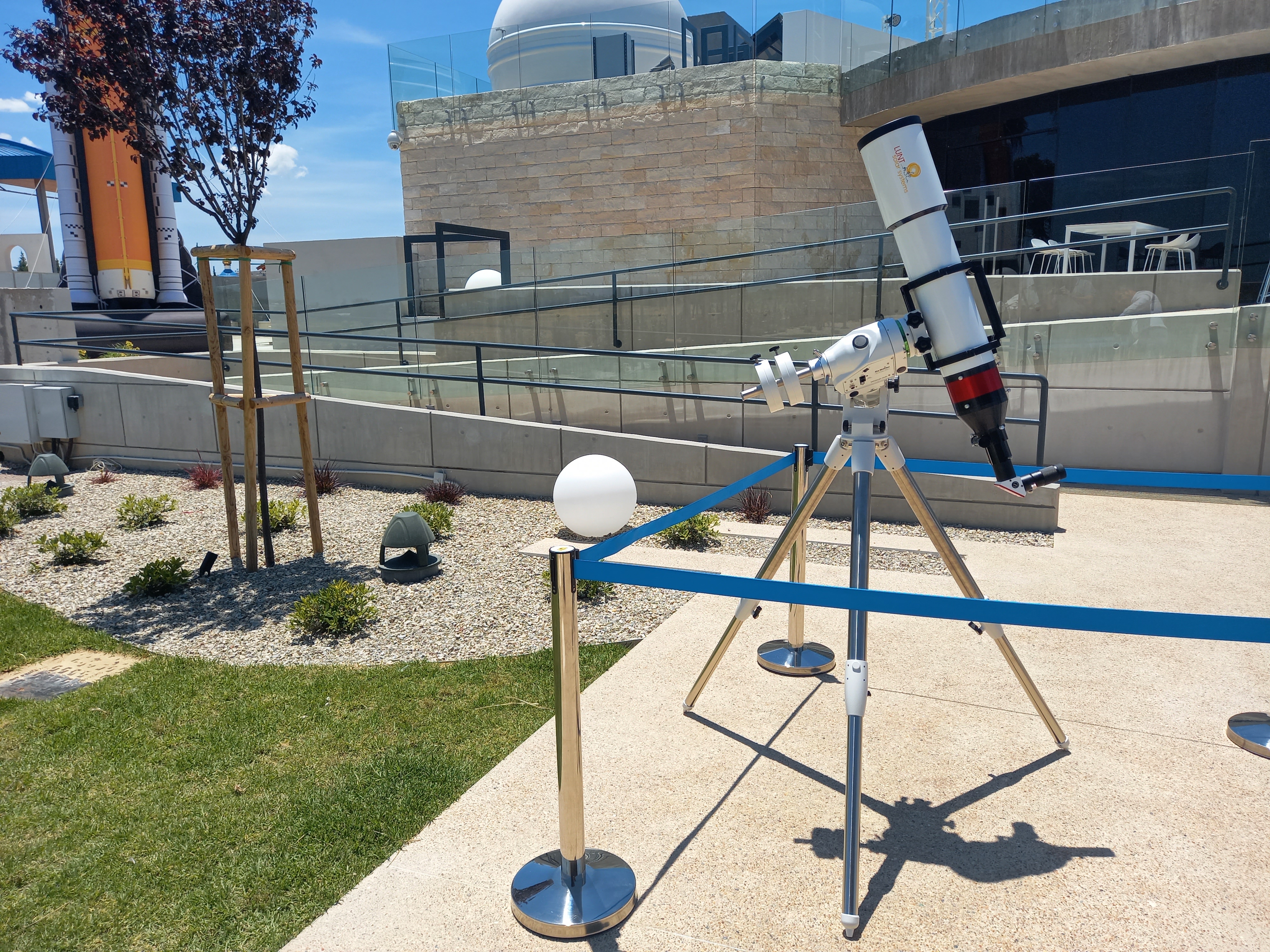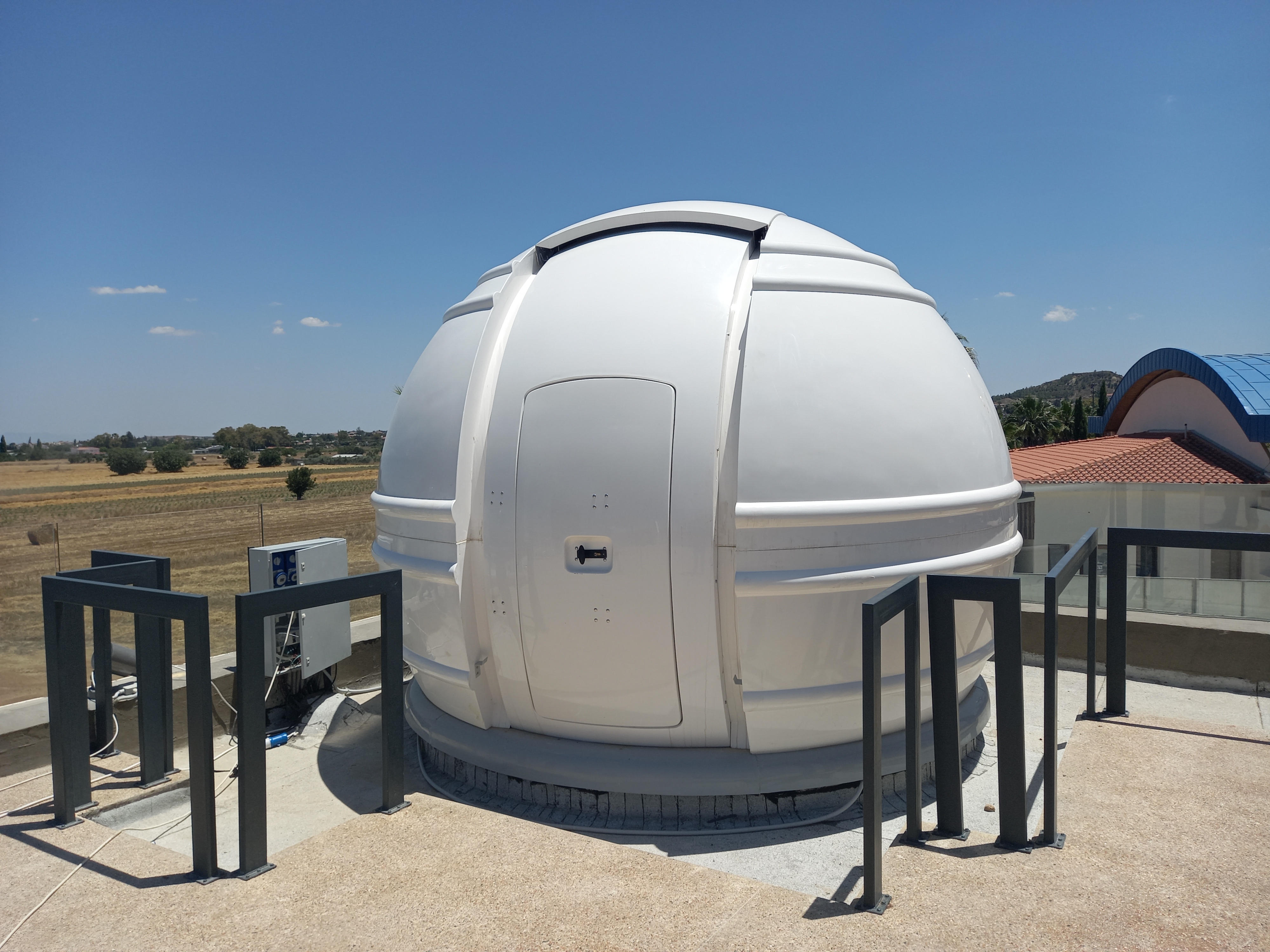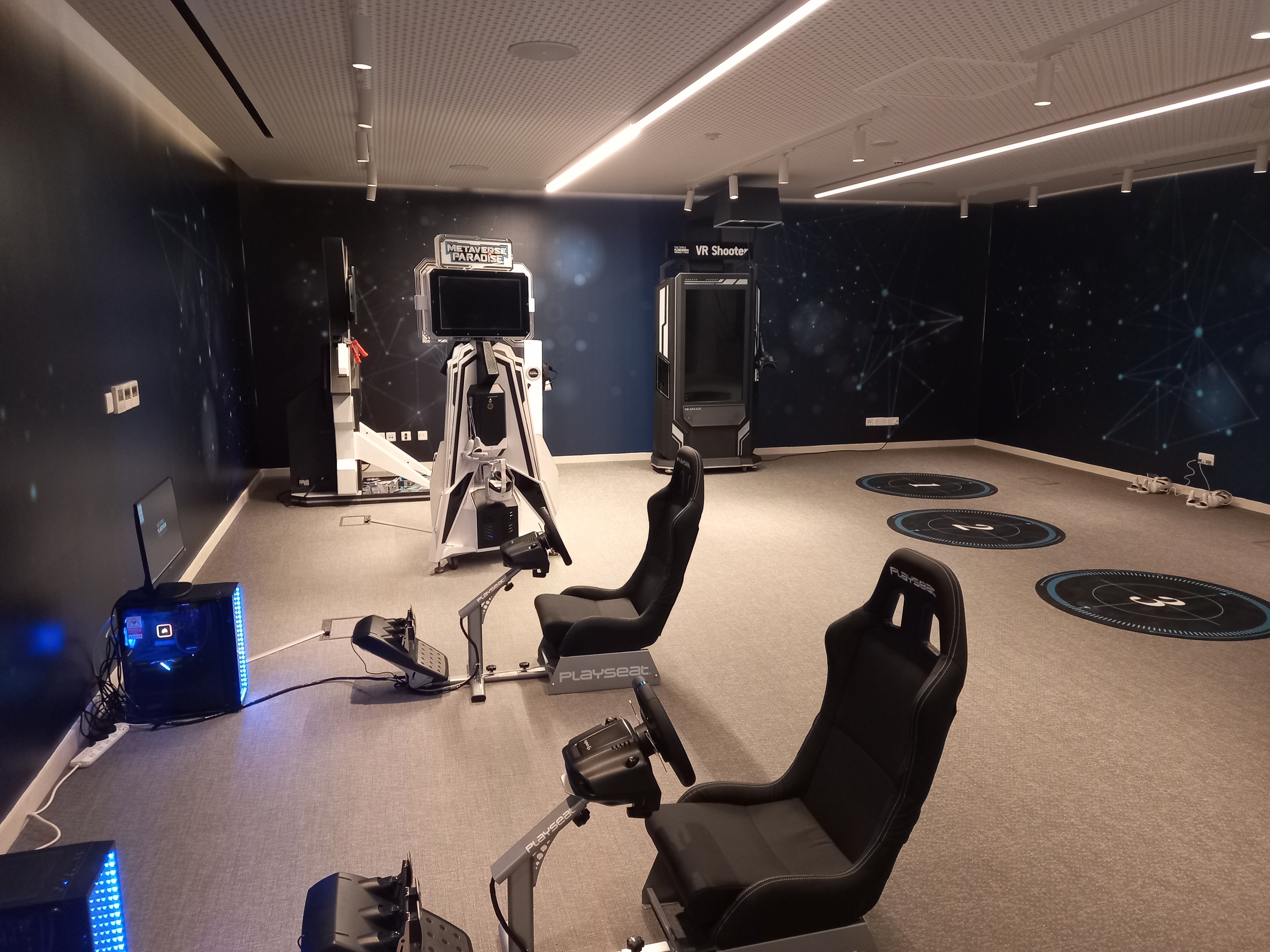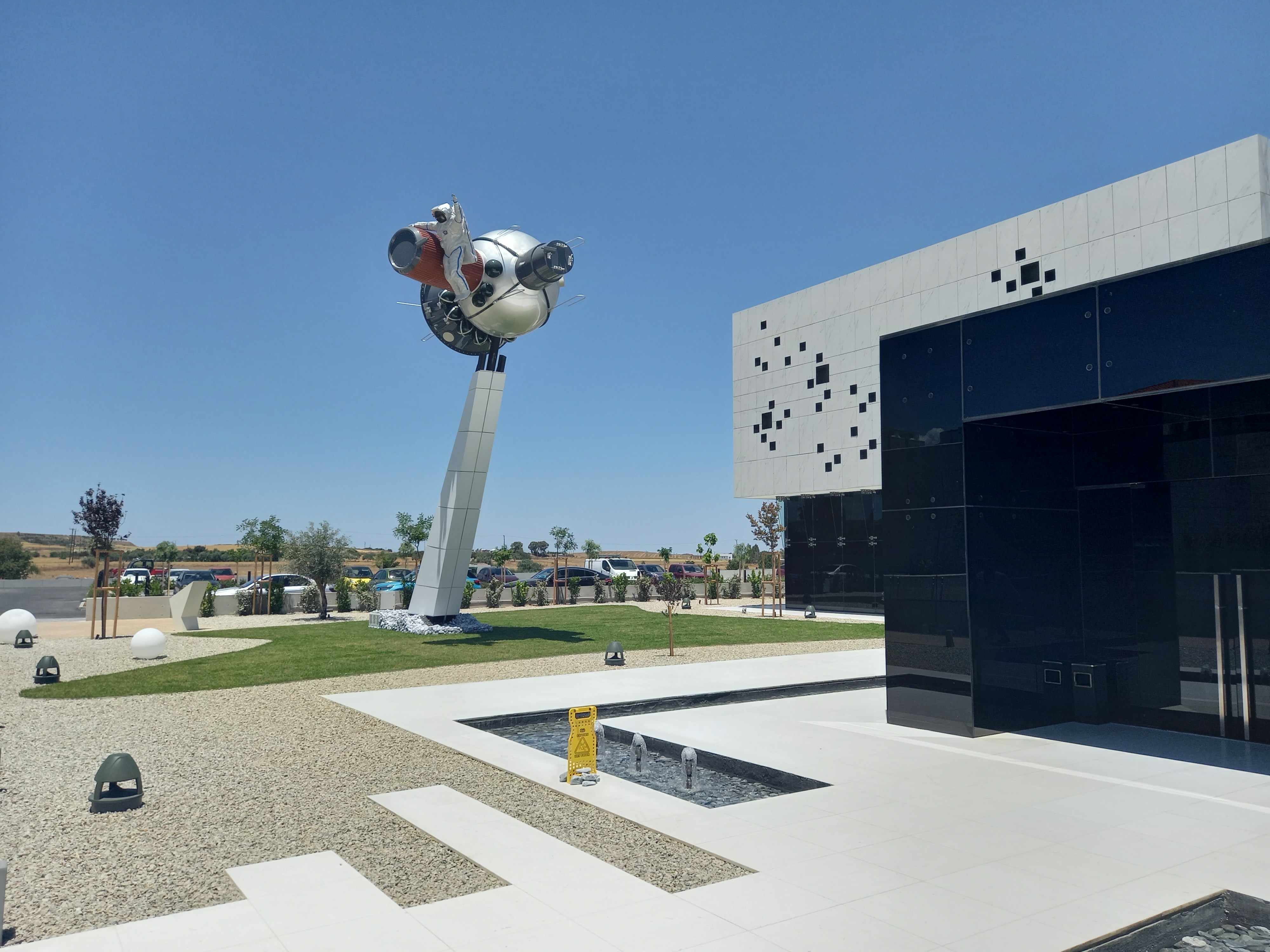

Pavlos Neophytou
Some people ask, "Does a planetarium merely provide answers, or does it also evoke questions?" Achilleas Kentonis, the executive director of the Interstellar Institute, responds, "First and foremost, it stimulates questions, and then answers naturally follow." He goes on to explain that space sciences are often referred to as the "theology of the sciences" due to their philosophical, existential, and cultural essence. They serve as a reminder of our profound insignificance in the vast expanse of the universe, while also emphasizing our vital role in safeguarding this delicate paradise we call Earth.
In the cafeteria of Cyprus' first planetarium, which began operating on Sunday, June 4, near the Metropolis of Tamassos and Orini in Nicosia, we engage in conversation with the executive director of the "Interstellar" Institute. He serves as the educational and scientific advisor for the private company "T&O Planetarium," which owns this project. Two two-meter astronaut dummies, one from NASA and one from the Russian Space Agency, "supervise" our discussion. Visitors traverse the corridors, leading either to the 18.25-meter-diameter dome projection room, one of the largest in Europe, or to the 360-degree virtual reality simulation room. Simultaneously, outside the building's glass, a group of young individuals can be seen operating a solar telescope, their gaze fixed on sunspots and eruptions (we were informed that the period of the sun's peak activity, showcasing spectacular images, will soon commence). Behind them, within an aboveground dome, lies one of the most advanced robotic telescopes in Cyprus, with a diameter of 35 mm and precise targeting capabilities. This telescope, like the solar telescope, can be operated from the comfort of one's home or office by any interested party, as the observations are transmitted live on a screen anywhere in the world. The helioscope is ideal for observing sunspots and flares.
The helioscope is ideal for observing sunspots and flares.
The 10 projectors of the projection system are state-of-the-art and provide high-definition resolution (9K). Most films are accompanied by commentary from an instructor.
"What is the Earth's place in the universe, and what are the limits of human perception?" we inquire of Mr. Kentonis. He responds, "That's a profound question. For us humans, the Earth is a blue paradise visible from the Moon. However, in the vast universe, the Earth is a minuscule speck, comprising only 5% of the universal mass and surrounded by 95% dark matter and dark energy. Other intriguing questions arise: Are we the sole universe within the... universe? How many dimensions can we explore in search of parallel universes? Did everything truly originate from the Big Bang? These inquiries, and many more, find their answers through the expertise of our scientific staff, lectures, courses, celestial observations, and captivating presentations within the dome of the Cyprus Planetarium. Nonetheless, let us not forget the wise words of Aldous Huxley: 'There is only one corner of the universe you can be certain of improving, and that is yourself'."
Chronology
Planetariums, which originally served as a means to visually depict stars, planets, and celestial objects, have evolved from primitive devices. The foundation of modern planetariums can be traced back to 1924 at the "Deutsches Museum" in Munich. Franz Meyer, the chief engineer of "Carl Zeiss" optics company, was tasked with constructing the most extensive mechanical planetarium of its time, capable of demonstrating both heliocentric and geocentric movements. The planets were set in motion along rails using electric motors, with Saturn's orbit spanning a diameter of 11.25 meters. Additionally, 180 stars were projected onto the walls through electric lamps. In 1983, Evans & Sutherland introduced the first planetarium projector capable of showcasing computer-generated graphics at the Hansen Planetarium in Salt Lake City. The latest generation of planetariums now utilizes fully digital projection systems featuring "full-dome video" technology, providing operators with immense flexibility to display not only the Earth's sky but also any desired image, including the night sky as seen from other planets. From left, Achilleas Kentonis (executive director of the "Interstellar" Institute), Giorgos Tzivas (press representative of "Interstellar") and Christos Triantafyllidis (director of the "Kyprus Planetarium").
From left, Achilleas Kentonis (executive director of the "Interstellar" Institute), Giorgos Tzivas (press representative of "Interstellar") and Christos Triantafyllidis (director of the "Kyprus Planetarium").
From Spyridakis' time
Regarding Cyprus, George Tzivas, the spokesperson for "Interstellar," informs "K" that the idea of establishing a planetarium has been discussed since 1967, when Konstantinos Spyridakis, the Minister of Education at the time, emphasized its significance for society and the advancement of science. Since then, passionate astronomy enthusiasts have developed educational programs and lectures driven by their enthusiasm. It started with improvised planetariums, followed by inflatable and hanging domes. Mr. Tzivas recalls that in 2003, he and the "Star School" introduced the inflatable planetarium called "Starlab" to Cyprus, which continues to visit schools for astronomy screenings. In 2004, it even participated in the events for the Olympic Games in Athens. However, the scale and quality of the "Cyprus Planetarium" have never been seen before on the island. It stands as the largest and most advanced planetarium in the Eastern Mediterranean, complete with its own observatory featuring a robotic dome and telescope, Tzivas proudly adds.
The screening room
The centerpiece of "Planetarium Cyprus" is its projection room, designed theatrically and equipped with 189 seats. Christos Triantafyllidis, the director of the planetarium, guides us through the 10 cutting-edge projectors of the projection system, boasting high-definition resolution (9K). While films of this caliber are yet to be produced, the impression of 4K resolution prevails, and the planetarium management believes that the projection room will keep up with technological advancements in the next decade. Mr. Triantafyllidis highlights the unique aspect of "Planetarium Cyprus" compared to most other planetariums worldwide. In the majority of the continuously screened films, a qualified instructor, typically an astrophysicist, is present to provide explanations to the audience based on the film's subject matter. At the end of each screening, the instructor engages with the audience, answering questions that range from simple to complex. "Our vision is to establish the ultimate educational hub for space enthusiasts and explorers, igniting curiosity, stimulating the imagination, and creating unforgettable experiences," emphasizes Mr. Triantafyllides. Screening of a film inside the dome on the opening day (Saturday, June 3), in the presence of the President of the Republic, Nikos Christodoulidis. The screening room has a capacity of 205 seats.
Screening of a film inside the dome on the opening day (Saturday, June 3), in the presence of the President of the Republic, Nikos Christodoulidis. The screening room has a capacity of 205 seats.
Adjacent to the screening room is the entertainment area, featuring a captivating 360-degree virtual reality experience. This immersive audio-visual simulation transports users into modified, enhanced, or alternate environments, enabling them to explore their surroundings in all directions, much like in real life. On the first floor, you'll find a conference room with a seating capacity of 90 and a remarkable 12.5-meter wall screen. In the basement, there is a space dedicated to virtual reality game simulators, where players can immerse themselves through a head-mounted screen, headphones, and one or more controllers. Above the restaurant, situated in the neighboring building, stands a magnificent 250-seat amphitheater designed for cultural events and scientific presentations on astronomical phenomena. Adjacent to the amphitheater, there is a modern observatory, further enhancing the facility's offerings.The 360-degree virtual reality simulation room. 10 swivel chairs allow the user to "experience" experiences such as launching a rocket, "visiting" planets of the solar system, a solar eclipse, but also skiing in a ski resort in the Alps. In fact, he has the ability to look around. in all directions, as it may actually do.
Relations with Universities and Society
What is the affiliation of Planetarium Cyprus with universities and other institutions, both domestic and international? Achilleas Kentonis responds, "Planetarium Cyprus has formed a strategic scientific partnership with the Interstellar Institute, which oversees educational programs, lectures, Astro-observations, research, and interdisciplinary collaborations." He further explains, "Through this collaboration, we have established memoranda of understanding with universities in Cyprus and numerous institutions abroad, as well as various centers of excellence and research organizations. Currently, Interstellar is actively involved in international research projects that showcase the abundance of talented scientists within our reach. The true value of these collaborations lies in the sharing of expertise and collective efforts to address common challenges for the advancement of science and the benefit of society. It is worth mentioning that the Honorary President of Cyprus Planetarium is Professor Thanasis Economou, an esteemed astronomer at the University of Chicago and a NASA Consultant. To us, he is more than a mentor. Our collaboration with him spans many years, starting from his discovery by journalist George Tzivas, who introduced him to our organization." Lecture by the Professor of Astronomy at the University of Chicago and NASA advisor, Thanasis Oikonomou, at the Cyprus Planetarium, due to his presence in Cyprus for the inauguration. On the Moon and Mars are scientific instruments that he designed. In his lecture, he talked about the return of man to the Moon in a few years, with the "Artemis" program.
Lecture by the Professor of Astronomy at the University of Chicago and NASA advisor, Thanasis Oikonomou, at the Cyprus Planetarium, due to his presence in Cyprus for the inauguration. On the Moon and Mars are scientific instruments that he designed. In his lecture, he talked about the return of man to the Moon in a few years, with the "Artemis" program.
 One of the most modern robotic telescopes available in Cyprus, 35 mm in diameter, with high precision aiming, offered, like the helioscope, for handling from the home or office of anyone interested.
One of the most modern robotic telescopes available in Cyprus, 35 mm in diameter, with high precision aiming, offered, like the helioscope, for handling from the home or office of anyone interested.
What is the societal impact of a planetarium?
"Planetariums have a significant influence on society, as they promote scientific literacy, cultivate a culture of curiosity, and, most importantly, foster a profound understanding and appreciation of the universe. They serve as a distinctive educational platform that greatly enhances civic engagement and cultural enrichment, contributing to the overall growth and well-being of a community. It is not uncommon for renowned scientists today to reflect on how their initial visit to a planetarium was a transformative experience that shaped their lives." A room with virtual reality game simulators, based on the immersion of the player, through a screen and head-mounted headset and one or more controllers. From sledding to skiing.
A room with virtual reality game simulators, based on the immersion of the player, through a screen and head-mounted headset and one or more controllers. From sledding to skiing.
 The two main buildings of the planetarium are separated by a small square, where an exact replica of a satellite is permanently exhibited.
The two main buildings of the planetarium are separated by a small square, where an exact replica of a satellite is permanently exhibited.
[This article was first published in Kathimerini's printed Sunday edition and translated from its Greek original]































